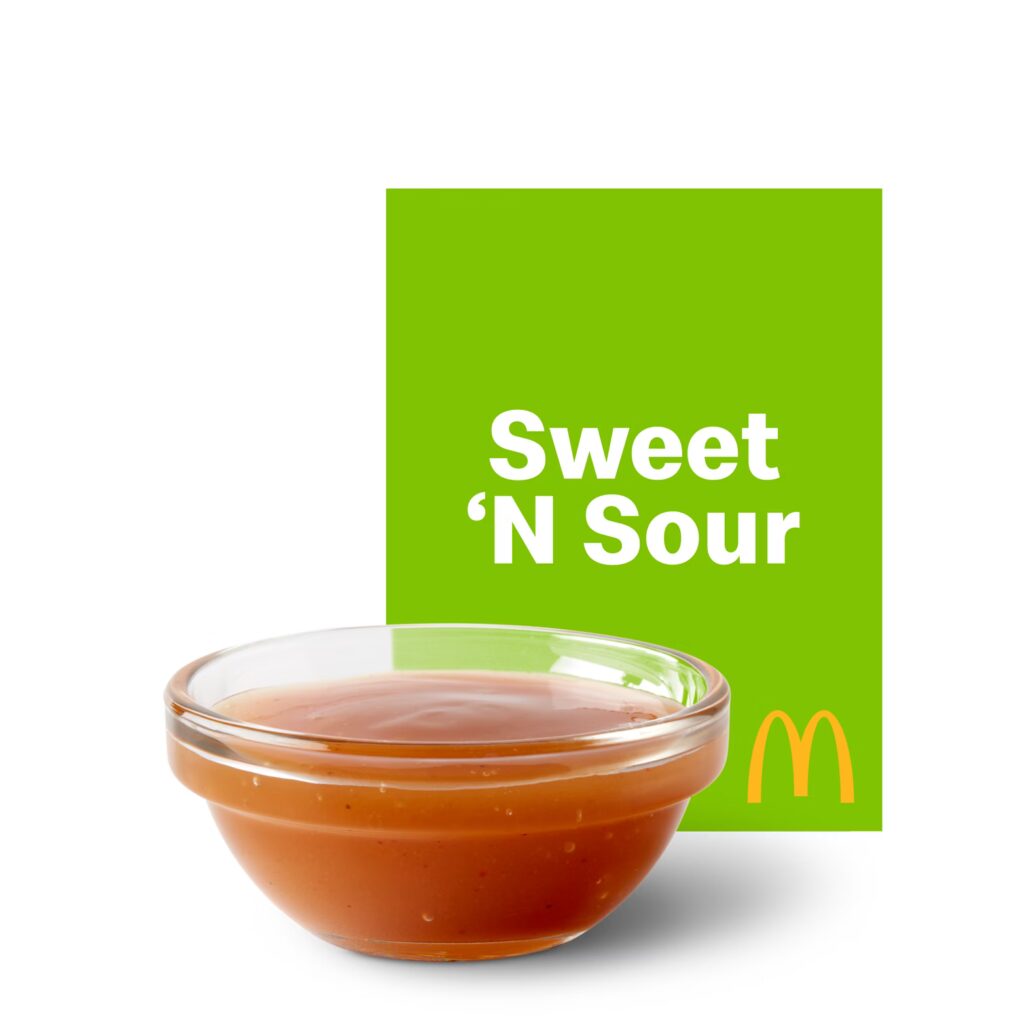People Are Just Now Learning The Secret Fruit In McDonald’s Sweet ‘n’ Sour Sauce

Something shifts in your brain when you discover what you’ve been eating all these years. Not the nutritional facts or calorie count. Something deeper. More personal. A radio host in Melbourne sat down to enjoy his favorite meal, nuggets dipped in that golden brown sauce he’d loved since childhood. In minutes, everything he thought he knew would change.
Lauren Phillips watched her co-host Jason Hawkins tear into his McDonald’s order with pure joy. She smiled as he proclaimed it a good day. He had no idea what was coming. No clue that she held information capable of destroying his relationship with his favorite food. One simple fact. One ingredient. One moment of truth that would spread across social media like wildfire, leaving thousands of fans questioning everything they thought they knew about their go-to dipping sauce.
But before we reveal what stunned Jason into throwing away a half-eaten nugget in disgust, we need to talk about a strange quirk of human nature. We love what we don’t understand. We devour what remains mysterious. And sometimes, knowledge feels less like power and more like a curse.
Apricot Drops the Bomb
@creative_habits #duet with @jaseandlauren OMG ITS TRUE!!! #mcdonalds #chickennuggets #sweetandsour #apricot
♬ original sound – Jase & Lauren
“Have you ever thought about what Sweet ‘n’ Sour sauce is made from?” Lauren asked while Jason happily munched his nuggets.
He hadn’t. Most of us haven’t. Food becomes background noise in our lives, fuel we consume without question. Jason dipped another nugget into that tangy, sweet mixture he’d enjoyed for years. He took a bite.
Lauren struck. “Would you believe it is apricot flavor?”
Jason froze mid-chew. His face contorted as if he’d just bitten into something rotten. “I hate apricot,” he said, voice thick with betrayal. “I can taste the apricot now.”
He tossed the half-eaten nugget aside like it had personally offended him. Years of happy meals, countless drive-thru runs, thousands of satisfied dips into that familiar sauce, all rendered meaningless by five words. Apricot was the main ingredient. Apricot had been there all along, hiding in plain sight, masquerading as something else entirely.
Fans Split Down the Middle

Social media exploded. TikTok users who watched the clip felt their own worlds tilt on their axis.
“You have now ruined my favorite McDonald’s sauce,” one viewer wrote, words dripping with genuine anguish.
Another declared, “I can now never have sweet and sour sauce again.”
People mourned. People raged. People questioned how they’d gone years, decades even, without knowing what they were eating. One viewer captured the existential crisis perfectly by writing, “I’m gonna pretend I didn’t hear about apricots.”
But others scoffed at the shock. “How do people not know about apricots?” someone asked with smug superiority. Another explained, “Sweet and sour is just apricot jam mixed with white vinegar.” Some claimed their mothers had been making apricot chicken for years. Of course it made sense. Of course fruit paired well with poultry. Of course this revelation seemed obvious in hindsight.
McDonald’s Australia even joined the chaos, leaving a comment that read, “Hear me out, try dipping your Soft Serve in Sweet and Sour Sauce.” Because when your fans are having an identity crisis about condiments, why not throw ice cream into the mix?
Why We Hate What We Once Loved
Here’s where it gets interesting. Jason didn’t just learn about apricots. He claimed he could suddenly taste them. His brain, armed with new information, rewired his sensory experience in real time. Before knowledge, the sauce was perfect. After knowledge, every dip carried the ghost of a fruit he despised.
We do what Jason did all the time. We love something until we learn something about it that challenges our comfort. Then we reject it completely, even though nothing about the thing itself has changed. Only our perception shifted. Only our awareness expanded. Yet somehow that feels like enough reason to abandon years of enjoyment.
But has nothing changed? Or has everything changed? When we pull back curtains and expose ingredients, we expose ourselves to a choice we didn’t know we had. Ignorance protected Jason’s bliss. Knowledge demanded he take a stand. Could he keep loving something now that he knew its secret? Could he separate taste from truth?
Breaking Down What’s Inside

McDonald’s website spells it out plain. Sweet ‘n’ Sour sauce blends flavors of apricot and peach with savory spices and leaves a slight lingering heat. Apricot isn’t hiding. It’s right there in the official description, bold as day, waiting for anyone curious enough to look.
Beyond the fruit purees, you’ll find high fructose corn syrup, soybean oil, modified food starch, dextrose, xanthan gum, and sodium benzoate as preservative. Cellulose gum thickens it. Dried chili peppers add that kick. Caramel color makes it brown. Extractives of paprika give it depth. Garlic powder and onion powder round out the flavor profile.
None of it sounds appetizing when you list it out. But mix it all together and millions of people worldwide reach for it without hesitation. Until they know. Until someone like Lauren pulls the thread and unravels the mystery.
And here’s a bonus revelation that nobody asked for but everybody needs to hear. McDonald’s Sweet Curry dipping sauce? Also made with apricots. Multiple sauces. Same secret. Same fruit base. Same potential for fan outrage when word gets out.
People Who Saw It Coming
Not everyone freaked out. Some viewers responded with calm acceptance, almost boredom at the so-called shocking revelation.
“Apricot goes so well with chicken that makes so much sense,” one person commented, as if confused by the confusion itself.
Others shared memories. “My mum used to make apricot chicken.” Home cooks who’d been combining the fruit with poultry for generations saw no scandal here, just basic culinary logic playing out in fast food form.
Someone broke it down to its simplest components. Apricot jam plus white vinegar equals sweet and sour. No mystery. No conspiracy. Just two common ingredients doing what they’ve always done, creating that balance between sugar and acid that humans crave.
But knowing and experiencing are different things. You can understand intellectually that apricots belong in the sauce. You can even appreciate the chemistry of it. But when you bite into something expecting one thing and your brain suddenly tags it as another, the disconnect can feel jarring. Jason knew chicken. He knew sauce. He didn’t know apricot. And now he couldn’t unknow it.
What Our Food Ignorance Says About Modern Life

We eat without thinking. We consume without questioning. We trust corporations to feed us things we’ll enjoy without ever wondering what makes those things enjoyable. Modern life moves too fast for investigation. We grab food, we eat it, we move on to the next task, the next meal, the next distraction.
One TikTok user who originally posted about the apricot discovery captured it well when she wrote, “Honestly I never even thought about it, I just ate it. Something told me to read the ingredient whilst eating my chippies and I was shoooooketh. It’s made me think so much about other stuff I just eat and don’t know what’s in it.”
She’s right to wonder. How many other foods hide ingredients we’d rather not know about? How many sauces contain fruits we didn’t expect? How many beloved menu items would lose their appeal if we actually read the labels?
Someone mentioned Caesar dressing in the comments, saying that finding out what goes into it destroyed their love for it. Raw egg yolk and anchovies can do that to a person. Once you know, you can’t unknown. Once you see, you can’t unsee.
But here’s where we need to ask ourselves a harder question. Is our ignorance serving us? Or is it making us passive consumers who surrender control over what enters our bodies? Comfort lives in not knowing. Power lives in awareness. Which do we value more?
Your Sauce, Your Choice

Jason threw away his nugget. Thousands of fans declared their McDonald’s orders ruined. But some kept eating, kept enjoying, kept recognizing that apricot or not, the sauce still tastes good to them.
Knowledge gives you options. You can reject what you now know. You can accept it and continue as before. You can even lean into it, appreciating the craftsmanship of blending apricot with spices to create something greater than its parts. What you cannot do is pretend you don’t know. What you cannot do is return to the innocence of mindless consumption.
Maybe that’s not such a bad thing. Maybe being present with our food, understanding what we’re eating, making conscious choices about what we put in our bodies leads to a richer experience overall. Maybe the shock wears off and acceptance settles in. Maybe you discover you actually like apricots when they’re mixed with garlic powder and chili peppers and served alongside crispy nuggets.
Or maybe you switch to another sauce. McDonald’s offers plenty of options. Barbecue. Ranch. Honey mustard. Each with its own list of ingredients waiting to surprise you if you care enough to look.
Your relationship with food mirrors your relationship with life. Do you want comfort or truth? Do you want ease or awareness? Do you want to float through experiences taking things at face value, or do you want to dig deeper, ask questions, demand transparency even when it challenges what you thought you knew?
Jason chose rejection. Others chose acceptance. You get to choose what works for you. But make the choice conscious. Make it deliberate. Because once you start asking what’s in your sauce, you might start asking what’s in everything else. And that question, uncomfortable as it may be, could change everything.
Loading...

